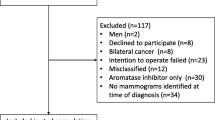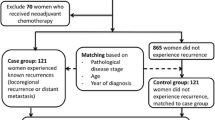Abstract
Background
Limited and conflicting data exist on an association between mammographic density (MD) and re-excision rates after breast-conserving surgery (BCS). Additionally, the correlation of MD with resection of unnecessary margins during initial BCS is unknown.
Methods
All women with a diagnosis of breast cancer from 2003 to 2012 and enrolled in a larger study on MD were evaluated. Operative and pathology reports were reviewed to determine margin resection and involvement. Mammographic density was determined both by breast imaging-reporting and data system (BI-RADS) classification and by an automated software program (Volpara Solutions). Additional margins were deemed unnecessary if the lumpectomy specimen margin was free of invasive tumor [≥2 mm for ductal carcinoma in situ (DCIS)] or if further re-excision was needed.
Results
Of 655 patients, 398 (60.8 %) had BCS, whereas 226 (34.5 %) underwent initial mastectomy. The women with denser breasts (BI-RADS 3 or 4) underwent initial mastectomy more frequently than the women with less dense breasts (40.0 vs. 30.5 %, respectively; p = 0.0118). Of the patients with BCS, 166 (41.7 %) required separate re-excision. Additional margins were taken during BCS in 192 (48.2 %) patients, with 151 (78.6 %) proving to be unnecessary. In the bivariable analysis, the patients with denser breasts according to BI-RADS classification and volumetric density showed a trend toward requiring more frequent re-excision, but this association was not seen in the multivariable analysis. The rate of unnecessary margins did not differ by breast density. In the multivariate analysis, the re-excision rates increased with DCIS (p < 0.0003) and decreased with resection of additional margins (p = 0.0043).
Conclusions
Mammographic density is not associated with an increased need for re-excision or resection of unnecessary margins at initial BCS.
Similar content being viewed by others
References
Darby S, McGale P, Correa C, et al. Effect of radiotherapy after breast-conserving surgery on 10-year recurrence and 15-year breast cancer death: meta-analysis of individual patient data for 10,801 women in 17 randomised trials. Lancet. 2011;378:1707–16.
Fisher B, Anderson S, Bryant J, et al. Twenty-year follow-up of a randomized trial comparing total mastectomy, lumpectomy, and lumpectomy plus irradiation for the treatment of invasive breast cancer. N Engl J Med. 2002;347:1233–41.
Bani MR, Lux MP, Heusinger K, et al. Factors correlating with re-excision after breast-conserving therapy. Eur J Surg Oncol. 2009;35:32–7.
Houssami N, Macaskill P, Marinovich ML, Morrow M. The association of surgical margins and local recurrence in women with early-stage invasive breast cancer treated with breast-conserving therapy: a meta-analysis. Ann Surg Oncol. 2014;21:717–30.
MacDonald H, Silverstein MJ, Lee LA, et al. Margin width as the sole determinant of local recurrence after breast conservation in patients with ductal carcinoma in situ of the breast. Am J Surg. 2006;192:420–2.
Martin-Dunlap TM, Cyr AE, Mushawah FA, Fao F, Margenthaler JA. Does the volume of ductal carcinoma in situ impact the positive margin rate in patients undergoing breast conservation for invasive breast cancer? J Surg Res. 2013;84:228–33.
Wang SY. Shamliyan T, Virnig BA, Kane RL. Tumor characteristics as predictors of local recurrence after treatment of ductal carcinoma in situ: a meta-analysis. Breast Cancer Res Treat. 2011;127:1–14.
Wang SY, Chu H, Samliyan T, Jalal H, Kuntz HM, Kane RL, Virnig BA. Network meta-analysis of margin threshold for women with ductal carcinoma in situ. J Natl Cancer Inst. 2012;104:507–16.
Reedijk M, Hodgson N, Gohla G, Boylan C, et al. A prospective study of tumor and technical factors associated with positive margins in breast-conservation therapy for nonpalpable malignancy. Am J Surg. 2012;204:263–8.
Smitt MC, Nowels K, Carlson RW, Jeffrey SS. Predictors of re-excision findings and recurrence after breast conservation. Int J Rad Oncol. 2003;57:979–85.
Blair SL, Thompson K, Rococco J, Malcarne V, Beitsch PD, Ollila DW. Attaining negative margins in breast-conservation operations: is there a consensus among breast surgeons? J Am Coll Surg. 2009;209:608–13.
McCahill LE, Single RM, Aiello Bowles EJ, et al. Variability in re-excision following breast conservation surgery. JAMA. 2012;307:467–75.
Moran MS, Schnitt SJ, Giuliano AE, et al. Society of Surgical Oncology–American Society for Radiation Oncology consensus guideline on margins for breast-conserving surgery with whole-breast irradiation in stages I and II invasive breast cancer. Int J Radiation Oncol Biol Phys. 2014;88:553–64.
Ananthakrishnan P, Balci FL, Crowe JP. Optimizing surgical margins in breast conservation. Int J Surg Oncol. 2012. DOI 10.1155/2012/585670.
Sabel MS, Rogers K,Griffith K, et al. Residual disease after re-excision lumpectomy for close margins. J Surg Oncol. 2009;99:99–103.
Shin H, Han E, Moon H, et al. Nomogram for predicting positive resection margins after breast-conserving surgery. Breast Cancer Res Treat. 2012;134:1115–23.
Mullen R, Macaskill EJ, Khalil A, et al. Involved anterior margins after breast conserving surgery: Is re-excision required? Eur J Surg Oncol. 2012; 38:302–6.
Balch GC, Mithani SK, Simpson JF, Kelley MC. Accuracy of intraoperative gross examination of surgical margin status in women undergoing partial mastectomy for breast malignancy. Am Surg. 2005;71:22–7.
Beron PJ, Horwitz EM, Martinez AA, et al. Pathologic and mammographic findings predicting the adequacy of tumor excision before breast-conserving therapy. Am J Roentgenol. 1996;167:1409–14.
Dillon MF, Maguire AA, McDermott EW, Myers C, Hill AD, O’Doherty A, Quinn CM. Needle core biopsy characteristics identify patients at risk of compromised margins in breast conservation surgery. Mod Pathol. 2008;21:39–45.
Fadare O, Clement NF, Ghofrani M. High- and intermediate-grade ductal carcinoma in situ of the breast: a comparison of pathologic features in core biopsies and excisions and an evaluation of core biopsy features that may predict a close or positive margin in the excision. Diagn Pathol. 2009. DOI:10.1186/1746-1596-4-26.
Kurniawan ED, Wong MH, Windle I, et al. Predictors of surgical margin status in breast-conserving surgery within a breast screening program. Ann Surg Oncol. 2008;15:2542–9.
Lovrics PJ, Cornacchi SD, Farrokhyar F, Garnett A, Chen V, Franic S, Simunovic M. The relationship between surgical factors and margin status after breast conservation surgery for early stage cancer. Am J Surg. 2009;197:740–6.
Melstrom LG, Melstrom KA, Wang EC, Pilewskie M, Winchester DJ. Ductal carcinoma in situ: size and resection volume predict margin status. Am J Clin Oncol. 2010;33:438–42.
Neushatz AC, DiPetrillo T, Steinhoff M, et al. The value of breast lumpectomy margin assessment as a predictor of residual tumor burden in ductal carcinoma in situ of the breast. Cancer. 2002;94:1917–24.
Sakr RA, Poulet B, Kaufman GJ, Nos C, Clough KB. Clear margins for invasive lobular carcinoma: a surgical challenge. Eur J Surg Oncol. 2011;37:350–6.
Wazer DE, Schmidt-Ullrich RK, Schmid CH, Ruthazer R, Kramer B, Safaii H, Graham R. The value of breast lumpectomy margin assessment as a predictor of residual tumor burden. Int J Radiat Oncol Biol Phys. 1997;38:291–9.
Kapoor NS, Eaton A, King TA, et al. Should breast density influence patient selection for breast-conserving surgery? Ann Surg Oncol. 2013;20:600–6.
Nicholson BT, LoRusso AP, Smolkin M, Bovjerg VE, Petroni GR, Harvey JA. Accuracy of assigned BI-RADS breast density category definitions. Acad Radiol. 2006;13:1143–9.
American College of Radiology. Breast imaging reporting and data system (BI-RADS) atlas. 4th edition. American College of Radiology, Reston, 2013.
Edge SB, Byrd DR, Compton CC, Fritz AG, Greene FL, Trotti A (eds). AJCC cancer staging manual. 7th ed. Springer, New York, 2010.
Huston TL, Pigalarga R, Osborne MP, Tousimis E. The influence of additional surgical margins on the total specimen volume excised and the reoperative rate after breast-conserving surgery. Am J Surg. 2006;192:509–12.
Acknowledgment
This research was supported by NIH training grant CA163177 and Department of Defense for “Building a Better Model: A Personalized Breast Cancer Risk Model Incorporating Breast Density to Stratify Risk and Improve Application of Resources,” PI: Jennifer Harvey, MD, University of Virginia, Charlottesville, Virginia, Proposal Number BC100474, Award Number W81XWH-11-1-0545, HRPO Log Number A-17074.
Conflict of Interest
Jennifer A. Harvey Volpara Solutions, Ltd. Wellington, New Zealand, Shareholder, research agreement; Hologic, Inc., Danbury CT, Shareholder, research agreement; VuComp, Inc., Dallas, TX. Research agreement. No other authors have financial disclosures.
Author information
Authors and Affiliations
Corresponding author
Rights and permissions
About this article
Cite this article
Edwards, B.L., Guidry, C.A., Larson, K.N. et al. Does Mammographic Density have an Impact on the Margin Re-excision Rate After Breast-Conserving Surgery?. Ann Surg Oncol 23, 782–788 (2016). https://doi.org/10.1245/s10434-015-4917-1
Received:
Published:
Issue Date:
DOI: https://doi.org/10.1245/s10434-015-4917-1




